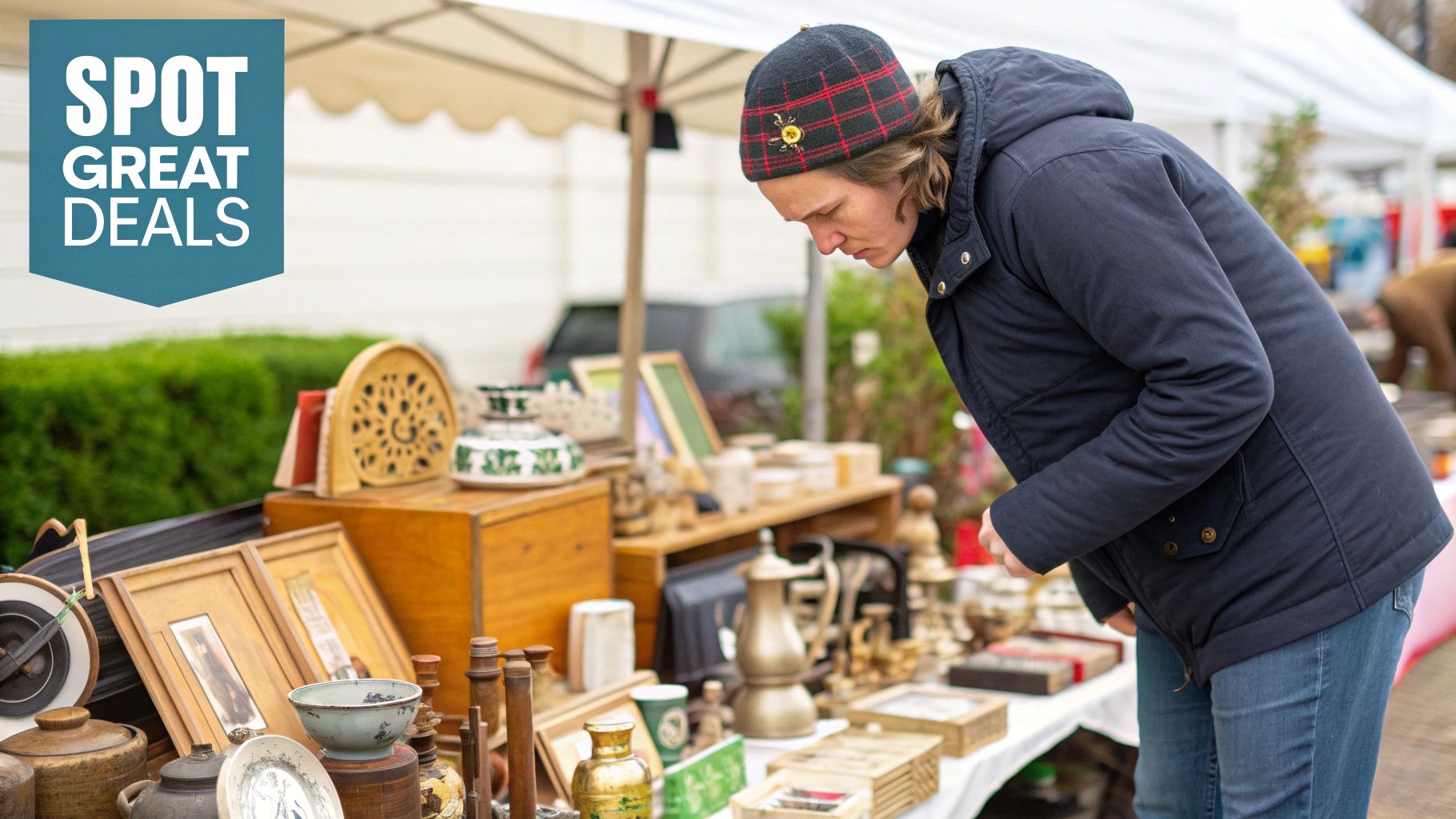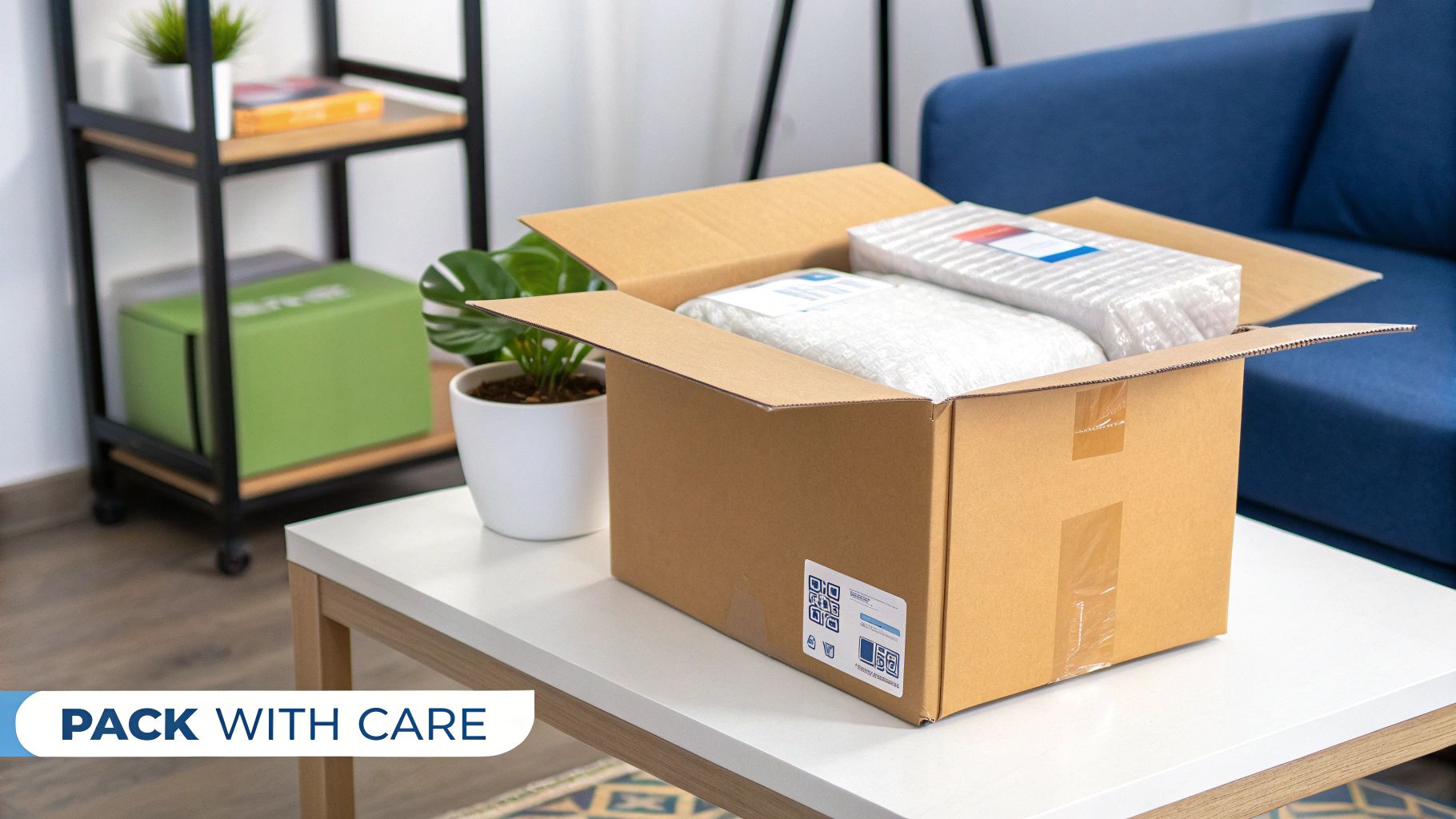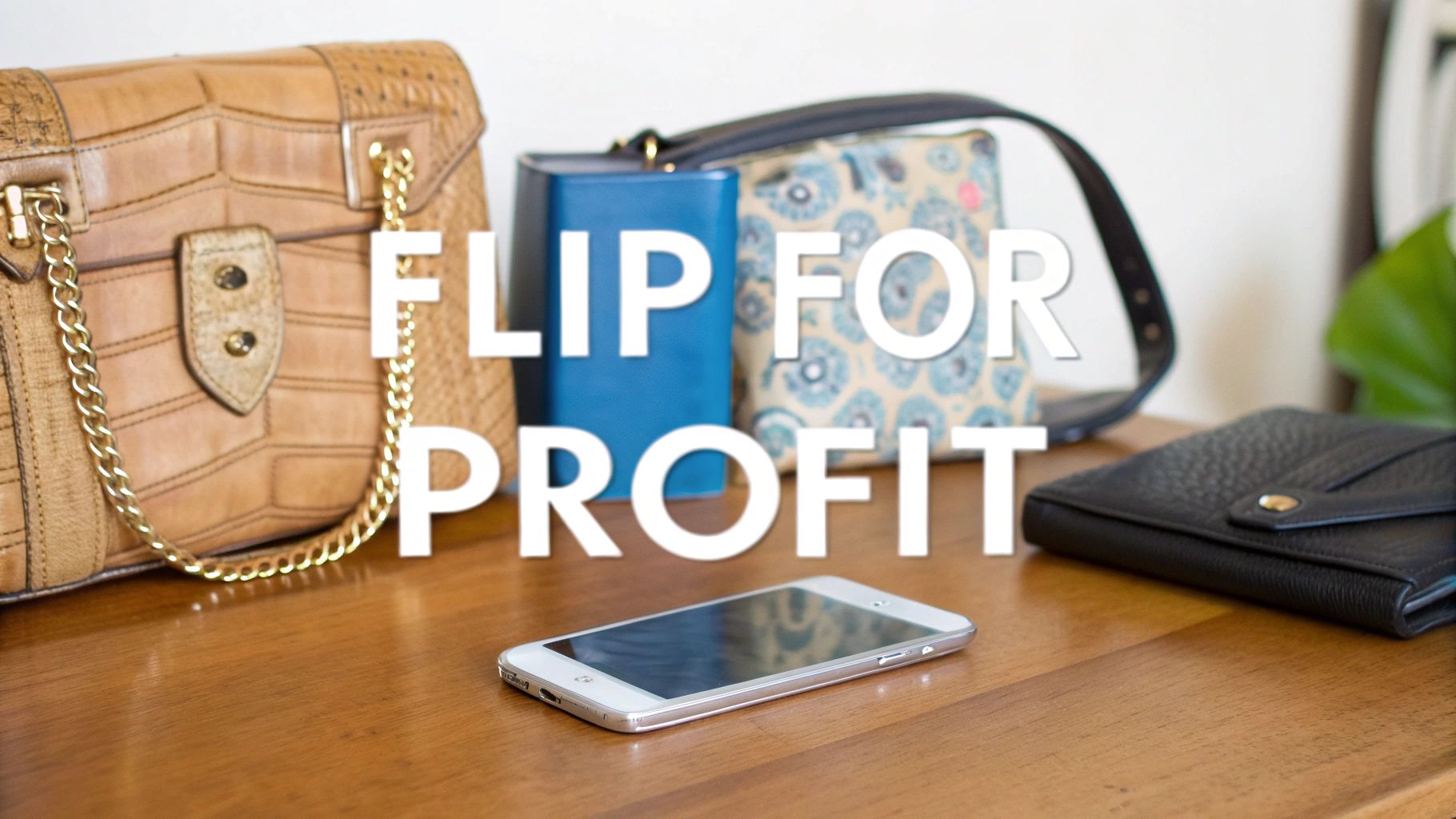So, you're ready to start flipping items for a profit? At its core, the idea is simple: you buy things for less than they're worth and sell them for more. But turning that simple idea into real money comes down to mastering three key things: knowing what people want, finding it cheap, and selling it smart.
The Foundations of Flipping
Think of flipping as developing a superpower for spotting hidden value. It's more than just a side gig; it’s a skill that trains your eye to find opportunities everywhere, from a cluttered garage sale to the endless scroll of online marketplaces. The real magic happens in that journey from spotting an underpriced gem to making a profitable sale.
Here’s a crucial piece of advice I learned early on: your profit is made when you buy, not when you sell. This simple shift in thinking changes everything. It forces you to focus on sourcing strategically instead of just thinking about the final sale price. Anyone can post an item online, but the flippers who consistently make money are the ones who get their inventory for the lowest possible price. That's what sets the stage for a great profit margin.
To help you get started, here's a quick look at the core principles that every successful flipper lives by.
Core Principles of Profitable Flipping
| Principle | Actionable Strategy | Why It Matters |
|---|---|---|
| Buy Low, Sell High | Source from thrift stores, garage sales, and clearance racks. Negotiate prices whenever possible. | This creates your profit margin. The lower you buy, the more room you have to make money, even after fees and shipping. |
| Know Your Market | Research what’s currently selling well. Focus on a niche you understand, like vintage toys, brand-name clothing, or electronics. | Selling in-demand items means faster sales and higher prices. Sticking to a niche makes you an expert who can spot deals others miss. |
| Create Value | Clean, repair, or restore items. Take high-quality photos and write compelling descriptions that highlight unique features. | Presentation is everything. A little effort can dramatically increase an item's perceived value and final selling price. |
| Sell Strategically | List items on the right platform for your product (e.g., eBay for collectibles, Facebook Marketplace for furniture). | Different platforms attract different buyers. Choosing the right one gets your item in front of the people most likely to pay top dollar. |
These principles aren't just abstract ideas; they are the day-to-day actions that separate a hobby from a profitable business. Internalizing them will guide every decision you make, from the moment you spot a potential flip to the moment you ship it to a happy customer.
Getting into the Flipper’s Mindset
To really succeed, you have to start thinking like a flipper and learn to see the potential that others overlook. That dusty, forgotten end table in the corner of a thrift store? It’s not just junk. With a good cleaning, a fresh coat of chalk paint, and some modern hardware, it could easily sell for a 300% markup.
This is the kind of vision that turns ordinary finds into consistent income. It’s a mindset built on a few key habits:
- Always Be Researching: Keep a pulse on what’s trending. I’m constantly using tools like the Curio app when I'm out sourcing to get a quick appraisal on an item before I even think about buying it.
- Embrace the Hunt: You won't strike gold on every trip. Real success in flipping comes from being persistent and having the patience to sift through a lot of duds to find the winners.
- Negotiate with Confidence: Learn how to negotiate respectfully but without emotion. Your goal is to get the best possible price for your inventory, and that means being prepared to walk away if the deal isn't right.
The best flippers I know don’t just find valuable items; they create value. They use their knowledge, a little bit of elbow grease, and smart marketing to turn a $5 chair into a $150 statement piece. It all starts with seeing what could be.
How to Find Your Profitable Niche
When you first dive into flipping items for profit, it’s easy to feel a bit lost. There are deals everywhere, but chasing every shiny object is a fast track to burnout. The real secret to making serious money? It’s all about specialization.
When you focus on one specific niche, you start to develop a sixth sense for it. You learn the market inside and out, spot trends before they go mainstream, and can instantly tell a real treasure from a piece of junk. It's about becoming the go-to expert in a category you genuinely enjoy, whether that's vintage clothing, rare video games, or mid-century modern furniture. That passion is what will keep you going and help you learn the tiny details that separate a small flip from a massive payday.
The Power of High-Margin Niches
Let's be honest, some categories are just more profitable than others. They have built-in demand from collectors, brand recognition that commands high prices, or are simply hard to find. The luxury resale market is a perfect example of a high-margin playground.
Things like designer handbags, fine jewelry, and classic vintage fashion aren't just one-time sales; they can actually gain value over time. For instance, recent analysis showed brands like Tiffany & Co. saw a 55% year-over-year sales jump on major resale sites. At the same time, the hunt for unique vintage fashion has exploded, with searches for unbranded vintage pieces shooting up by 201%. This surge is fueled by social media and a bigger shift toward sustainable shopping.
Specialization is your most powerful tool in flipping. It transforms you from a treasure hunter into a market expert, allowing you to build a reliable, profitable business around what you know and love.
A great way to get a feel for what’s hot in the luxury space is to see what dedicated platforms are pushing. Sites like The RealReal are a goldmine for research, showing you exactly how top-tier items are priced and presented to attract buyers.

Looking at curated collections like this gives you a direct line into what high-end shoppers want right now. By studying these platforms, you'll start to understand the nuances of pricing, what makes certain brands pop, and how to position your own finds for the best possible return.
Choosing the Right Niche for You
Finding your sweet spot is a mix of following the money and following your gut. You don't need to be an encyclopedia on day one, but having a real interest in a category will make the learning curve feel less like work and more like a hobby.
As you brainstorm, think about these key things:
- What's Your Knowledge Base? Start with what you already know. If you’ve been a gamer your whole life, you have a huge head start in spotting rare games and consoles that a newbie would walk right past.
- Can You Actually Find This Stuff? How easy is it to source items in your area? A niche in antique nautical gear is going to be a tough sell if you live in Nebraska. Scout your local thrift stores, flea markets, and online marketplaces to see what's out there.
- Think About Logistics. Flipping large furniture can be wildly profitable, but do you have a garage to store a credenza and a truck to deliver it? Be realistic about storage space and shipping challenges from the get-go.
Once you have a few ideas brewing, it’s time to start digging in. For a deeper dive into specific product categories with fantastic profit potential, check out our guide on the best items to resell for profit. It’s packed with actionable ideas to help you zero in on a niche and start building your flipping empire.
The Art of Sourcing Undervalued Items
Your journey to flipping items for profit really kicks off with sourcing—that's the skill of finding valuable stuff for pennies on the dollar. Success here isn’t about dumb luck. It's about building a repeatable strategy for spotting opportunities where others just see junk.
I can't stress this enough: your profit is made the moment you buy, not when you sell. Getting good at acquiring inventory cheaply is the single most important part of this whole business. It means you need to stop wandering aimlessly through thrift stores and start hunting with a purpose.

Uncovering Deals on Facebook Marketplace
Facebook Marketplace can be a goldmine, but you've got to be smart about it. A lot of sellers aren't trying to get top dollar; they just want their stuff gone now. This urgency is your opportunity.
Your goal is to find these deals before anyone else does. To do that, get specific.
- Set up saved searches with keywords for your niche. Don't just search for "furniture." Instead, search for brands like "West Elm" or materials like "solid wood."
- Look for motivated sellers. Use search terms like "moving sale," "must go," or "OBO" (or best offer). These are signals that someone is ready to make a deal.
- Act fast. When a good listing pops up, message them immediately. Be polite, clear, and ready to negotiate respectfully.
Here's a pro tip: Don't scroll past listings with bad photos or vague descriptions. These are often where the best deals are hiding because they get skipped over. A blurry photo of a "wood dresser" could easily be a mid-century modern gem worth hundreds.
Mastering Flea Markets and Garage Sales
Flea markets and garage sales demand a totally different approach. It's all about timing. The best stuff is usually found right when they open or at the very end of the day. Early birds get fresh inventory, while latecomers can scoop up items from sellers who are desperate to not pack it all back up.
You have to develop a quick eye for quality. Learn to spot the little things, like dovetail joints on drawers or the distinct patina on old metal. When you see something with potential, pull out an app like Curio for a quick appraisal. Having that data in your hand lets you decide on the spot if it's a profitable flip. This is a huge advantage over other shoppers who are just guessing.
High-Profit Categories to Target
While you can find profit almost anywhere, some categories are just consistently better bets. Furniture flipping, for instance, has exploded. Demand is high, and the profit margins are fantastic. It’s not unusual for flippers to make around $200 in profit per sofa, with average margins sitting near a healthy 50%.
The market for used electronics is another giant. Just look at used iPhones—they generate nearly $1.5 million in monthly sales on Amazon alone. Focusing on these kinds of high-demand goods is a reliable way to build your business. If you want to dig deeper, you can review flipping data and trends on amzscout.net to find even more hot markets.
Top Sourcing Channels Comparison
Knowing where to look is half the battle. Each channel has its own quirks and requires a slightly different game plan.
| Channel | Pros | Cons | Best For |
|---|---|---|---|
| Facebook Marketplace | Local, fast-moving inventory, easy to search. | Highly competitive, requires quick action. | Furniture, electronics, baby gear, items from motivated sellers. |
| Garage/Yard Sales | Extremely low prices, potential for huge finds. | Hit-or-miss, requires early mornings or late-day visits. | Household goods, vintage items, tools, kids' toys. |
| Flea Markets | Wide variety of items, good for niche hunting. | Can have more knowledgeable sellers, prices might be higher. | Antiques, collectibles, unique decor, vintage clothing. |
| Thrift Stores | Constant new inventory, organized by category. | Can be picked over quickly, requires frequent visits. | Clothing, books, housewares, small furniture. |
Ultimately, the best flippers I know don't stick to just one source. They mix it up, understand the rhythm of each channel, and are always on the lookout for the next great find.
Creating Listings That Sell Fast
Finding a hidden gem for a great price is a rush, but that's only half the battle. Now you have to turn that potential into actual cash. The way you present your item online is what makes or breaks the sale. A killer listing doesn't just show what you're selling; it tells a story, builds trust, and convinces someone that your find is exactly what they’ve been searching for.
Think of it this way: all your hard work sourcing and researching leads to this one moment. From the photos you snap to the description you write, every single detail counts toward getting top dollar.
Crafting Product Descriptions That Actually Work
Your description is your one-on-one sales pitch. It needs to be crystal clear, brutally honest, and persuasive all at once. The real goal is to get inside a buyer's head, anticipate their questions, and answer them before they even have to ask. Doing this builds immediate confidence and cuts down on the endless back-and-forth messages that can kill a sale's momentum.
A solid description always nails these points:
- Precise Measurements: Don't just guess and call it a "large dresser." Give the exact height, width, and depth. This is non-negotiable for furniture.
- Honest Flaw Disclosure: Be upfront about any scratches, dings, or quirks. Pointing out the imperfections shows you're a trustworthy seller and prevents nasty surprises or disputes later.
- The Story and Special Details: Did you spot a faint maker's mark? Is it crafted from solid tiger oak? These are the details that create value and justify your price. For more on this, our guide on how to sell vintage items is packed with tips for telling a great story.
Don't just list facts; paint a picture. Instead of writing "brown leather chair," try something like, "A perfectly broken-in leather armchair that’s just begging for a spot in your reading nook." Help them see it in their own home.
Picking the Right Place to Sell
Where you list your item is just as critical as the listing itself. Different platforms attract different kinds of buyers. For most flippers, the decision boils down to two heavyweights: eBay and Facebook Marketplace, each with its own strengths.
- eBay: This is your go-to for anything shippable, especially collectibles or niche items with high demand. You get access to a massive global audience of serious buyers who know what they're looking for.
- Facebook Marketplace: It's the undisputed champion for local sales. It's perfect for bulky, heavy items like furniture that are a nightmare to ship. The biggest perk? No seller fees, so all the profit is yours.
Don't sleep on niche marketplaces, though. Sometimes, a specialized platform is where the real money is. Take watches, for example—one of the most stable and profitable categories you can flip. Back in 2018, consumers in the U.S. alone spent over $82.4 billion on watches and jewelry. High-end brands can deliver profit margins between 20% and 60%. For these, a site like Chrono24 is essential to connect with serious collectors. Musical instruments are another goldmine, with iconic brands like Fender and Gibson offering similar returns.
A quick browse on Chrono24 shows you exactly what serious buyers expect: detailed specs, professional photos, and clear pricing.

This level of quality is the standard on specialized sites, and it’s a great reminder of why a top-notch listing is so important, no matter where you choose to sell.
Scaling Your Flipping Operation Into a Business

There’s a moment every successful flipper experiences. It’s when your weekend hobby starts to feel like something much bigger. The spare room is now an inventory room, you're on a first-name basis with your postal carrier, and the extra income is getting serious. This is the crossroads where you shift from just flipping stuff to building a real business.
Making that leap isn’t about working yourself to the bone. It's about working smarter. The real goal is to handle more items and make more sales without your profit margins taking a hit or, just as importantly, without you burning out. It all comes down to creating simple, repeatable systems that can grow with you.
Get Your Financials in Order
You absolutely cannot manage what you don’t measure. Guessing at your profits is the fastest way to run your new venture into the ground. When you're starting out, a basic spreadsheet is your best friend—it’s the single most important tool for turning pro.
For every single item you flip, your spreadsheet needs to track a few key things:
- Item Description: What is it? Be specific enough that you know what it is at a glance.
- Source: Where did you find it? (e.g., Goodwill, Facebook Marketplace, Garage Sale).
- Purchase Date & Cost: Exactly what you paid and when.
- Sale Date & Price: The final price the customer paid you.
- Fees & Shipping Costs: All those little bites from platforms and payment processors, plus what you spent on postage.
- Net Profit: The magic number! (Sale Price - Purchase Cost - Fees - Shipping).
This isn't just boring data entry; this is intelligence. It tells you which thrift stores are goldmines and which are duds. It shows you which product categories are actually making you money, letting you ditch the guesswork and focus on what works.
Tracking every penny is the most important habit you can build. It's the only way to truly understand the health of your business and identify opportunities to improve your margins.
Tame Your Time and Workspace
As your inventory piles up, the chaos can quickly take over your life and your living space. A messy, disorganized process is an efficiency killer. The key is to create dedicated zones for your inventory and dedicated time blocks for your tasks.
Try sketching out a simple weekly schedule. Maybe Monday and Tuesday evenings are for sourcing trips. Wednesday night is for cleaning and photos. You can draft and schedule listings on Thursday, and then spend Friday packing up all the week's sales. This kind of structure keeps you from feeling constantly behind and overwhelmed.
Once the closet and garage are bursting at the seams, it's time to think about dedicated storage. This doesn't have to be a massive warehouse—a simple set of shelves will do, or even a small storage unit. A $50 monthly storage unit might seem like a big expense, but if it lets you buy and hold more profitable inventory, it can easily pay for itself ten times over.
With these foundational systems in place, you’ll be ready to make things official. For a complete guide on what comes next, check out our article on how to start a resale business.
Common Questions About Flipping Items
Getting into the reselling game always sparks a few questions. It's totally normal. Whether you're just starting to dip your toes in or you're trying to scale up, getting solid answers can be the difference between making a profit and losing your shirt.
Let's cut through the noise and get right to the practical stuff. I want to give you some real, actionable advice based on years of experience, so you can start flipping with confidence.
How Much Money Do I Need to Start?
This is the big one, and the answer might surprise you: you can get started with less than $50. Seriously. The trick is to focus on finding inventory that costs you next to nothing—or is even free. Your first goal isn't to hit a home run; it's just to get on base with a few small, easy wins.
Here’s where I’d look first:
- Curb Alerts: People leave perfectly good stuff on the sidewalk all the time. I've seen a little cleaning and a fresh coat of paint turn a free piece of furniture into an easy $100.
- Thrift Store Back Racks: Make a beeline for the clearance section. This is where the dollar bins and 50% off tags live. A vintage t-shirt you snag for $2 can easily flip for $20 online.
- Garage Sale End Times: Roll up to a garage sale as it's winding down. Most people are so tired of sitting there that they'll practically give things away just to avoid hauling it all back inside.
The strategy is simple: roll your profits. That first $20 you make gets reinvested into a slightly better item, which might bring in a $50 profit. You just keep snowballing your cash from there, building your flipping fund without putting your own money at risk.
What Are the Biggest Mistakes to Avoid?
I see new flippers make the same costly mistakes over and over. If you can sidestep these common traps, you'll protect your profits and save yourself a ton of headaches.
The absolute biggest error is buying with your gut instead of with data. Just because you like something doesn't mean the market will. Before you buy anything, do your homework. A quick search on eBay's "sold" listings will show you exactly what people are actually paying for that item right now.
Never, ever guess on shipping costs. A heavy or awkwardly shaped item can eat up your entire profit margin in postage. Figure out your shipping costs before you list the item, not after you've already made the sale.
Another thing that drives me crazy is lazy listings. Blurry photos and a one-sentence description scream "amateur." This just invites lowball offers and makes it nearly impossible to get your asking price. Spend an extra ten minutes taking clear, well-lit photos and writing a detailed, honest description. It's a small effort that pays off big time.
How Do I Handle Large or Fragile Items?
Big, bulky, or delicate items can seem like a nightmare, but they’re completely manageable if you have a plan. For anything large like furniture or exercise equipment, your best friend is "local pickup only."
Platforms like Facebook Marketplace and Craigslist are built for this. You skip the shipping headaches, get paid in cash, and you're done. If you find a truly amazing piece that needs to be shipped, you can look into a service like uShip to get quotes from independent movers, but be prepared for the cost.
When it comes to fragile stuff, packing is everything. Don't be cheap here.
- Wrap it like you mean it. Lots of bubble wrap.
- Use brand new, sturdy boxes. It's worth the investment.
- Slap "Fragile" stickers on every single side of the package.
- Most importantly, factor the cost of your packing materials and shipping insurance into your final price.
Ready to stop guessing and start knowing? The Curio app is like having an antique expert in your pocket. Get instant identification, learn the history behind your finds, and get quick appraisals on the spot. Find out if you've got a treasure on your hands. Download Curio and make your next flip your most profitable one yet at https://www.curio.app.
